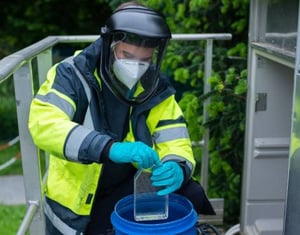In times of war, the best advice is always to know your enemy and anticipate its next move. This analogy applies equally to the importance of tracking the Covid-19 pandemic by monitoring local authority wastewater, because doing so provides essential information about how the SARS-CoV-2 virus is circulating in the community. You can then use that information to put in place the right measures for reducing the spread of the pandemic and protecting your residents.
It was at the end of March 2020 that people began talking about the possibility of wastewater being contaminated with SARS-CoV-2, the coronavirus responsible for the Covid-19 pandemic. The thinking was that such contamination could threaten the health and safety of wastewater treatment plant personnel. Not to mention anyone exposed to the watercourses into which treated wastewater was discharged.
Fortunately, those health concerns were allayed very quickly. According to the experts, the risk of SARS-CoV-2 remaining infectious in water discharged from wastewater treatment plants is minimal, and therefore the risk of human contamination is negligible. On the other hand, analyzing wastewater appears to be an effective way of monitoring the health status of a given population. In practical terms, there is a clear correlation between the number of genome units found in the wastewater analyzed and the number of positive tests in the population responsible for generating that waste.
Analyses that complement epidemiological information

Experience has shown that the detection of the SARS-CoV-2 coronavirus in wastewater can precede even the first appearance of symptoms in the local population by a few days. So identifying traces of coronavirus in the wastewater of a local authority area may provide the impetus for:
- Health authorities to conduct more analyses to track the trend of results
- Launching a PCR or antibody testing campaign to discover more about how the virus is circulating in the population and introduce specific public protection measures.
This approach is comparable to that in place for bathing water, although in this case there is still no regulation in place to govern the monitoring of coronavirus circulation in the community, which is hardly surprising given the short period of hindsight available.
- The basic idea is to begin by assessing the current situation, and preparing a vulnerability profile or risk profile.
- The next step is to introduce ‘continuous’ monitoring of SARS-CoV-2 circulation.
- The public can then be informed of the results of these analyses via the mayor’s office to provide reassurance. Or invited to contribute to local authority discussions on possible actions for implementation. Clearly, such measures can never replace the invaluable work done by health authorities, which are obviously the best qualified to decide on such issues.
Leveraging the expertise of the operator to do more

Nevertheless, these analyses of wastewater can provide data and information that may complement those made available by Regional Health Agencies, because they can indicate trends and thresholds. Based on the experience of the Obépine network (the epidemiological observatory for wastewater that was set up very quickly after the health crisis broke), the experts at Saur Group quickly came to the realization that analysis results indicating around one million genome per liter was the level at which local authorities should be alerted to its epidemic status. Results around 100,000 genome units per liter indicate that monitoring should be stepped up, while results of between 10,000 and 1,000 genome units per liter pose less of a concern.
On the basis of the results obtained at the treatment plant inflow point, the expertise of the operator - Saur - means that it is possible to suggest and organize (where necessary) sampling at a number of different points in the wastewater system. The aim of doing so is to identify the origin of these infection levels soon as soon as the viral load begins to rise.
Conducting the same type of average daily sampling on all the main inflow branches of the network (those serving the most at-risk establishments, such as schools, hospitals and nursing homes, for example) helps the local authority to become more responsive and implement the necessary measures more quickly.
For more information: